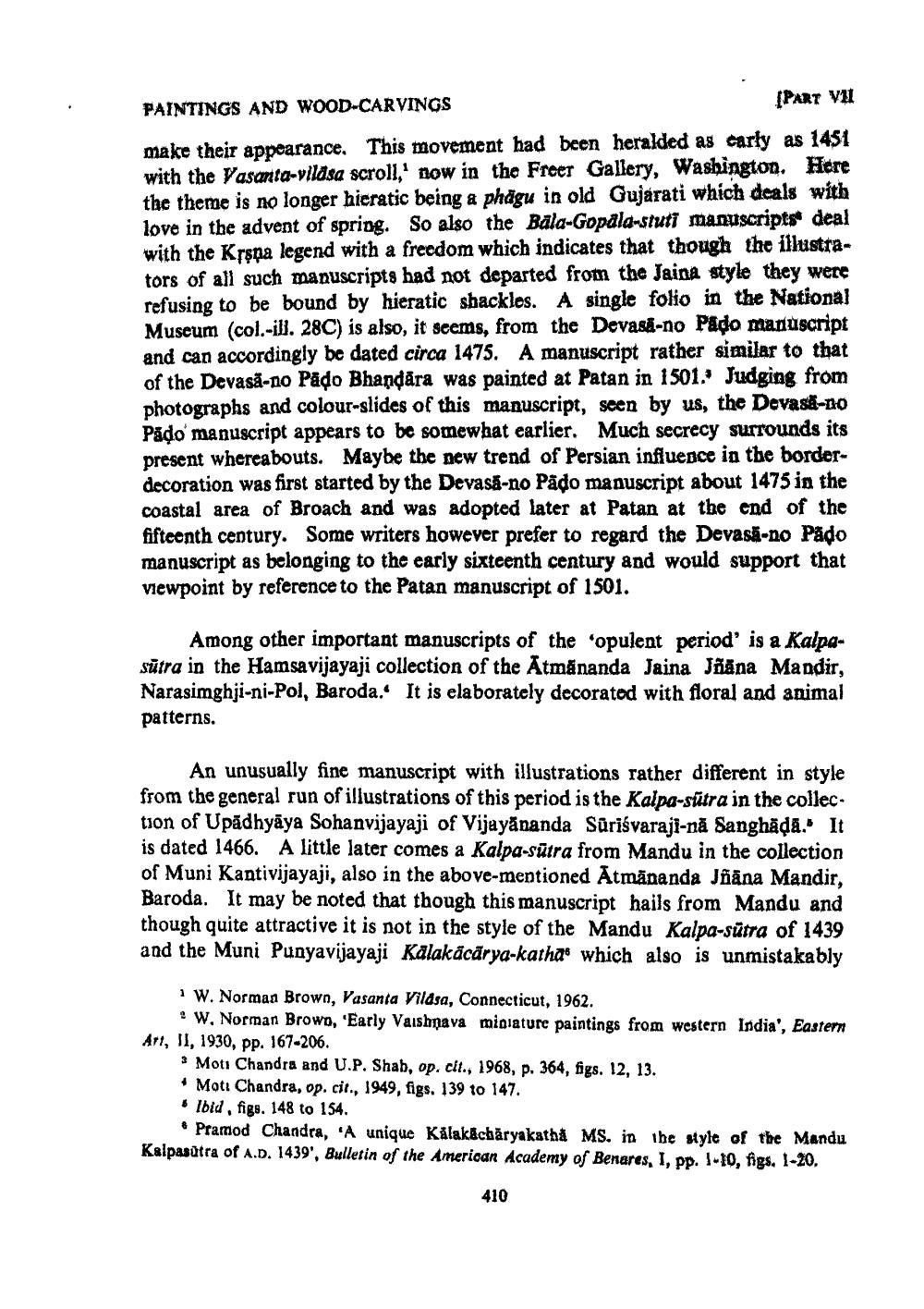________________
PART VU
PAINTINGS AND WOOD-CARVINGS
make their appearance. This movement had been heralded as carly as 1451 with the Vasanta-vilasa scroll,' now in the Freer Gallery, Washington. Here the theme is no longer hieratic being a phägu in old Gujarati which deals with love in the advent of spring. So also the Bala-Gopala-stuti manuscripts deal with the Krsna legend with a freedom which indicates that though the illustrators of all such manuscripts had not departed from the Jaina style they were refusing to be bound by hieratic shackles. A single folio in the National Museum (col.-ill. 28C) is also, it seems, from the Devasi-no Pido manuscript and can accordingly be dated circa 1475. A manuscript rather similar to that of the Devasã-no Pado Bhandara was painted at Patan in 1501. Judging from photographs and colour-slides of this manuscript, seen by us, the Devasa-no Pado manuscript appears to be somewhat earlier. Much secrecy surrounds its present whereabouts. Maybe the new trend of Persian influence in the borderdecoration was first started by the Devasá-no Pädo manuscript about 1475 in the coastal area of Broach and was adopted later at Patan at the end of the fifteenth century. Some writers however prefer to regard the Devasã-no Pado manuscript as belonging to the early sixteenth century and would support that viewpoint by reference to the Patan manuscript of 1501.
Among other important manuscripts of the 'opulent period' is a Kalpasutra in the Hamsa vijayaji collection of the Atmānanda Jaina Jääna Mandir, Narasimghji-ni-Pol, Baroda. It is elaborately decorated with floral and animal patterns.
An unusually fine manuscript with illustrations rather different in style from the general run of illustrations of this period is the Kalpa-sutra in the collection of Upadhyāya Sohanvijayaji of Vijayānanda Sūriśvaraji-nă Sanghäda. It is dated 1466. A little later comes a Kalpa-sütra from Mandu in the collection of Muni Kantivijayaji, also in the above-mentioned Atmānanda Jñana Mandir, Baroda. It may be noted that though this manuscript hails from Mandu and though quite attractive it is not in the style of the Mandu Kalpa-sūtra of 1439 and the Muni Punyavijayaji Kalakācārya-kathas which also is unmistakably
1 W. Norman Brown, Vasanta Vilasa, Connecticut, 1962.
2 W, Norman Browo, 'Early Vaishnava migiature paintings from western India', Eastern Ari, II, 1930, pp. 167-206.
Moti Chandra and U.P. Shab, op. cit., 1968, p. 364, figs. 12, 13. • Moti Chandra, op. cit., 1949, figs. 139 to 147. . Ibid, figs. 148 to 154.
. Pramod Chandra, 'A unique Kalakachăryakatha MS. in the style of the Mandu Kalpasūtra of A.D. 1439', Bulletin of the American Academy of Benares, 1, pp. 1-10, figs. 1-20.
410




